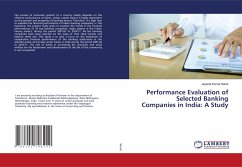
Capital Structure Management of Public Limited Companies
Versandkostenfrei!
Versandfertig in 6-10 Tagen
36,99 €
inkl. MwSt.

PAYBACK Punkte
18 °P sammeln!
The success of each industry can be evaluated through the value of its firm. Capital structure plays vital role to increase the profitability to ensure the minimum cost of capital and maximum return to the equity holder. Capital represents the funds available to the company for its business. The capital structure refers to the proportions of funding derived from debt and equity. Capital structure is usually measured by the debt equity ratio or by proprietorship ratio (or shareholders ratio). The two principal sources of finance for a business firm are equity and debt. What should be the propor...
The success of each industry can be evaluated through the value of its firm. Capital structure plays vital role to increase the profitability to ensure the minimum cost of capital and maximum return to the equity holder. Capital represents the funds available to the company for its business. The capital structure refers to the proportions of funding derived from debt and equity. Capital structure is usually measured by the debt equity ratio or by proprietorship ratio (or shareholders ratio). The two principal sources of finance for a business firm are equity and debt. What should be the proportions of equity and debt in the capital structure of a firm? The findings of the ratio between equity and debt are capital structure management. The choice of a firm's capital structure is a marketing problem. It is essentially concerned with how the firm decides to divide its cash flows into two broad components, a fixed component that is earmarked to meet the obligations towards debt capital and a residual component that belongs to equity shareholders.












